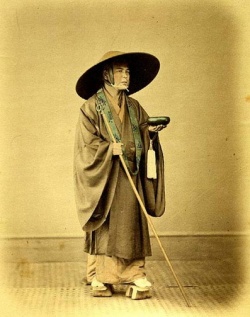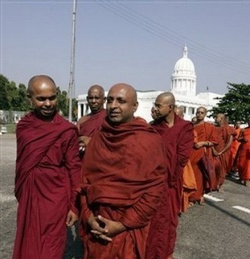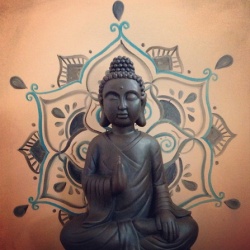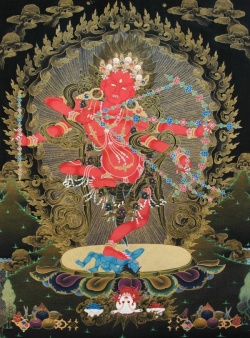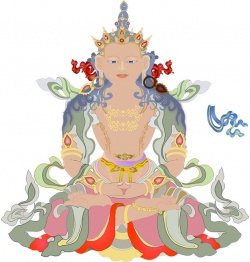Mahāvaipulya Sūtra of the Inconceivable State of Tathāgatas
Mahāvaipulya Sūtra of the Inconceivable State of Tathāgatas
Translated from Sanskrit into Chinese in the Tang Dynasty
by
The Tripiṭaka Master Śikṣānanda from Yutian
Thus I have heard:
At one time the Buddha attained samyak-saṁbodhi under the bodhi tree in the kingdom of Magadha. This bodhi tree was called Aśvattha. It had firm deep roots, and its trunk was straight, rounded, and without joints, like a sandalwood column. Birds circled this tree, but none were able to fly over it. The tree bark was fine and lustrous, with various colors, like beautiful silk. The dense foliage was bright green, spreading over multitudinous branches. In full bloom and emitting fragrances, wonderful and lovely flowers surrounded this tree. Except for the celestial kovidāra tree and pārijāta tree, no other trees could compare. Furthermore, surrounded by innumerable small trees, this king of trees was majestic and graceful, like a wonderful high mountain overlooking other mountains. All could see it from one yojana away. In the midst of fragrances wafting everywhere, it radiated glorious light. This tree seen from a distance at night might be taken as a bunch of fireworks. Under this tree was beautiful landscaping open to the four directions, like a joyous garden carpeted with lush grass as beautiful as peacock feathers. People never tired of beholding it.
In this place sat majestically the Tathāgata, surrounded by the multitudes, like the moon in the midst of stars. Meanwhile, Buddhas from elsewhere, as numerous as dust particles in ten Buddha Lands, for the purpose of adorning the multitudes in Vairocana’s bodhimaṇḍa, assumed the form of Bodhisattvas and came to be seated in this assembly. Among them were Avalokiteśvara Bodhisattva, Mañjuśrī Bodhisattva, Earth Store Bodhisattva, Space Store Bodhisattva, Vajra Store Bodhisattva, Vimalakīrti Bodhisattva, Excellent awesome Light Bodhisattva, Removing Coverings Bodhisattva, Jewel Hand Bodhisattva, Great Wisdom Bodhisattva, and Samantabhadra Bodhisattva. Bodhisattva-Mahāsattvas such as these were at the head of this assembly.
In addition, innumerable thousands of koṭis of Bodhisattvas, appearing as voice-hearers, also came to be seated in this assembly. At the head of this group were Śāriputra, Mahāmaudgalyāyana, Subhūti, Rāhula, Ājñātakauṇḍinya, Mahākāśyapa, Upāli, Aniruddha, Revata, Ānanda, Devadatta, Upananda, and others. Having long practiced the six pāramitās, they were getting near attainment of Buddha bodhi. In order to deliver sentient beings in this impure land, they appeared as voice-hearers. Also present, led by Mahāprajāpatī, were innumerable thousands of bhikṣuṇīs. All these bhikṣuṇīs had accomplished the deeds of great men. In order to tame headstrong sentient beings, they appeared in female form. In attendance as well were innumerable Brahma-kings, Śakras, and world protectors, as well as gods, dragons, gandharvas, asuras, garuḍas, Kiṁnaras, mahoragas, humans, nonhumans, and others. They all were great Bodhisattvas, and none were ordinary beings.
At that time the World-Honored One, seated under the bodhi tree, was sublime, pure, and wondrous, like a wish-fulfilling jewel under the pārijāta tree. His right mindfulness was unwavering, like Mount Sumeru. To make Bodhisattvas and sentient beings understand the awesome spiritual power of Buddhas’ profound and secret dhyāna, He entered the samādhi called the Inconceivable State of Tathāgatas. Immediately, the World-Honored One’s thirty-two physical marks each manifested innumerable Buddha Lands in the ten directions and their Buddhas, like images reflected in a clear mirror. Moreover, the Buddha’s eighty excellent characteristics each displayed His training in the Bodhisattva Way in the past, from the time when He had been King Radiance to the time [when He had been training] under Dīpaṁkara Buddha. Also displayed were all His difficult actions and ascetic practices, such as giving away His head, eyes, body, skin, flesh, hands, and feet, as well as wives, servants, thrones, palaces, and so forth.
Great mighty power arises from this samādhi. All Buddhas are constantly in this samādhi as they eat, walk, expound the Dharma, or enter parinirvāṇa. Why? Because all Tathāgatas rely on this samādhi to achieve immeasurable great spiritual power, to verify that all dharmas are empty, and to manifest at will various kinds of things in all Buddha Lands in the ten directions. For example, a person sees various kinds of magical things in a dream. When he wakes up, what he has seen is gone. Thus, ordinary beings, living in dreams fabricated by ignorance [of the truth), mistakenly perceive dharmas as real. By contrast, Buddhas, after enlightenment, are not captivated by anything. Hence, they can manifest at will, in a single thought, immeasurable Buddha work in all worlds in the ten directions, to benefit sentient beings and to bring them to accomplishment, enabling them all to enter the immeasurable, profound, wondrous Liberation Door.
Then Virtue Store Bodhisattva, who had not yet completed his training in the Bodhi Way, asked Samantabhadra Bodhisattva-Mahāsattva, “What is the name of the samādhi that the Tathāgata has just entered? How can it be acquired? Why can He manifest at will various kinds of Buddha work in all worlds in the ten directions, in order to deliver sentient beings?”
Samantabhadra Bodhisattva said to Virtue Store Bodhisattva, “Hearken! Hearken! I will explain to you.”
Meanwhile, all other Bodhisattvas single-mindedly gazed at him with respect, praising with one voice: “What a good question! It is profound and wonderful. Holy Samantabhadra, who knows and sees all, is now going to speak.”
Forthwith, the earth quaked in six different ways, the sky rained down wonderful flowers, and all sentient beings with afflictions and in pain found respite.
Samantabhadra Bodhisattva said, “Buddha-Son, this samādhi is called the Inconceivable State of Tathāgatas. It is the bodhi of all Buddhas because they constantly stay in it. As soon as the World-Honored One received from Dīpaṁkara Buddha the prophecy of attaining Buddhahood, He immediately entered this samādhi. Without effort, He has since responsively manifested immeasurable Buddha work. As on the tip of a hair in space lie Buddha Lands as numerous as the dust particles in all Buddha Lands, He demonstrates in each land such events: whether He is born in Tuṣita Heaven; whether He descends from that heaven and enters His mother’s womb; whether He becomes a newborn child and walks seven steps, announcing, ‘I now am at the edge of repeated birth and death’; whether he stays in the palace then renounces family life to undertake ascetic training; whether he subjugates māras, attains samyak-saṁbodhi, and turns the wondrous Dharma wheel; whether He abides in the world and delivers sentient beings for innumerable kalpas, enabling them to leave their suffering; whether He enters parinirvāṇa. He manifests that all kalpas equal one kṣaṇa or that one kṣaṇa equals all kalpas, while each kalpa and each kṣaṇa neither decreases nor increases. As long as sentient beings have not all been liberated, kṣaṇa after kṣaṇa, He constantly does these various kinds of Buddha work everywhere in these worlds, never taking rest, nor making any effort.
“Without effort, thought after thought, He not only manifests Buddhas’ various guidelines and majestic deportment, in innumerable worlds on the tip of one hair in space, but also manifests them even [in worlds) on the tips of innumerable hairs throughout space. Moreover, each dust particle in these worlds contains lands greater in number than the dust particles in all Buddha Lands. In one kṣaṇa, everywhere in each of these lands, spontaneously displayed is Buddhas’ majestic deportment, such as being born in heaven, entering parinirvāṇa, or liberating innumerable asaṁkhyeyas of sentient beings. Thus, thought after thought into the endless future, Buddhas are constantly doing Buddha work to benefit sentient beings. They will never rest, even if the domain of space and the realm of sentient beings come to an end. However, Buddha Lands never decrease, and dust particles never increase. Why? Because all dharmas are like mirages and are not firm.
“For example, in the kingdom of Magadha, only twelve yojanas across, in this assembly great Bodhisattvas, as numerous as dust particles in ten Buddha Lands, stay together without crowding one another. Likewise, each of those dust particles contains innumerable Buddha Lands. Some of these worlds face upward, and others face downward. Some face each other, and others face outward. Some are alongside one another, and others interpenetrate without obstructing one another. By analogy, one may see in a dream various kinds of things in the same place. Because they are unreal, they do not exclude one another.
“All these worlds are nothing but manifestations of one’s mind: whether a world burning at the ending of a kalpa, or the fire already burnt out; whether a world being formed by wind; whether clean or filthy things; whether the absence of a Buddha. Sentient beings perceive various kinds of distinctions according to their karmas. For example, driven by hunger and thirst, hungry ghosts go to the Ganges. Some of them see water, but others see the river filled with impure things, such as ash, pus, blood, and feces.
“Thus, sentient beings each follow their karmas. Some may see their own Buddha Land as pure or impure. Some may see a Buddha living or entering parinirvāṇa. Some may see Him in a bodhimaṇḍa, pronouncing the Dharma to the multitudes. Some may hear Him pronouncing the highest truth. Some may hear Him pronouncing and praising the dharma of almsgiving. Some may see Him standing still or walking. Some may see Him sitting or eating. Some may see His body twice or even seven times the size of a human, or one, one hundred, or one thousand yojanas in height. Some may see His awesome radiance like that of a rising sun or a full moon. Some may see Buddhas, assuming the form of great Bodhisattvas of awesome virtue, come to this assembly from their own lands.
“By contrast, because of karma hindrances, some may happen to live long after a Buddha-Tathāgata has entered parinirvāṇa. Some may never hear Buddhas’ names, like those hungry ghosts that cannot see water in the Ganges but can see only various kinds of filthy things.
“Sentient beings in one land may only see their world burning at the ending of a kalpa; sentient beings crowding another land may all see a Buddha. Some may see the Tathāgata put all lands into one Buddha Land; others may see Him put one Buddha Land into every land.
“People with diseased eyes see things in the same place differently, without hindering one another. Because of the eye disease, they are unable to see the true form. This is true for all sentient beings. Although the true nature of form is unobstructed, their mental conditions are different. Ignorant of the right views, they do not understand true reality.
“Buddha-Son, I now will tell you in brief the dharma for staying in this samādhi. As a Buddha-Bhagavān abides in this samādhi, in one thought He is everywhere in innumerable Buddha Lands on the tips of hairs throughout space. Moreover, contained in each of the dust particles in these Buddha Lands are lands as numerous as the dust particles in the dharma realm. For benefiting sentient beings, kṣaṇa after kṣaṇa, everywhere in one and all lands are displayed the skillful ways and the majestic deportment of Buddhas, who are as numerous as the dust particles in ten Buddha Lands. Such displays will never end for all sentient beings that have not attained the unsurpassed bodhi. Thus, not only one Buddha, but also another, and another, and even all the Buddhas [in worlds) in the ten directions each display the great powers of their awesome virtues.”
Having heard these words, then and there Virtue Store Bodhisattva acquired this samādhi. Forthwith, he saw innumerable Buddhas and knew their awesome virtues and skillful ways. With the power of this samādhi, he was able to tame sentient beings in the same way. Moreover, Bodhisattvas, as numerous as the sands of one hundred Ganges Rivers, each achieved various kinds of endurance in samādhis and attained various (Bodhisattva) Grounds.
Avalokiteśvara Bodhisattva and other great Bodhisattvas on the Tenth Ground are already complete in their merits and wonderful actions. Having acquired this samādhi far back in the past, they have been able to include innumerable kalpas within one kṣaṇa, to store innumerable lands in one dust particle, and to be everywhere in all lands with one thought. They have been delivering innumerable sentient beings without effort because they can manifest Buddha work at will. Although they heard this Dharma just now, they made no further progress. Like a full bottle of water placed in the rain, with no room for a single raindrop, such are these Bodhisattvas.
At that time the World-Honored One, in this samādhi, emitted from between His eyebrows the light called the great display. All the Bodhisattvas who had to do things with effort because they had not yet attained the Tenth Ground on the Bodhisattva Way, once touched by that light, immediately saw innumerable Buddha Lands on the tips of hairs in space, as well as Buddha Lands in dust particles. As one can see the white mustard seeds in an aquamarine jar, likewise these Bodhisattvas clearly saw all the Buddha Lands in dust particles. They also saw all the Buddhas in those lands. In one Buddha’s body, they saw all Buddhas.
Each and every Buddha has innumerable names for benefiting each and every sentient being. Thought after thought, He spontaneously and responsively appears in every Buddha Land and attains anuttara-samyak-saṁbodhi. By analogy, a wish-fulfilling jewel placed on the top of a high cylindrical banner naturally rains down various kinds of treasures according to sentient beings’ wishes, to satisfy them. Likewise, Tathāgatas demonstrate their attainment of anuttara-samyak-saṁbodhi and naturally deliver innumerable sentient beings.
In any land, sentient beings are all different, but they do not get in one another’s way. Each is like someone traveling across space through transcendental powers, unobstructed by mountains, rivers, and cliffs. Why? Because all life-journeys are like mirages. They are not solid.
Having seen such displays, all the Bodhisattvas saw themselves physically present everywhere in all lands. In one thought, they came before each and every Buddha and made offerings respectfully for one kalpa, two kalpas, three kalpas, or even 100,000 kalpas, or for the duration of one thought, or for a kṣaṇa. They heard each Buddha pronounce the Dhāraṇī Door of Pāramitās or explain various (Bodhisattva) Grounds. Or they saw Him demonstrate spiritual powers, such as including all kalpas within one thought. Perceiving such displays as extraordinary and rare to encounter, they each thought: “How did the World-Honored One, with commanding awesome virtue, have me acquire in one kṣaṇa merit and roots of goodness, which need innumerable kalpas to acquire, and enable me to master so quickly the great, awesome spiritual power of the Samādhi of the Inconceivable State of Tathāgatas?”
Then Virtue Store Bodhisattva, in order to benefit sentient beings, further asked Samantabhadra Bodhisattva, “For those who wish to attain this samādhi, what kind of merit, almsgiving, and wisdom should they accumulate?”
Then Samantabhadra Bodhisattva, who, everywhere in all Pure Lands in the ten directions, demonstrates attaining the perfect enlightenment and transforming sentient beings, told Virtue Store Bodhisattva, “Buddha-Son, to attain this samādhi, one should first accumulate merit and develop one’s roots of goodness, that is, one should persistently make offerings to the Buddha, the Dharma, and the Saṅgha, as well as one’s parents. One should draw in all who are poor, wretched, helpless, homeless, and pitiable, never abandoning them. One should not begrudge even one’s own body or flesh. Why? Because those who make offerings to the Buddha will acquire great merit. They will quickly attain anuttara-samyak-saṁbodhi and enable sentient beings to gain peace and happiness. Those who make offerings to the Dharma can enhance their wisdom and verify the Dharma with ease. They will have the right understanding of the true nature of dharmas. Those who make offerings to the Saṅgha will acquire immeasurable merit and wisdom as provisions required for attaining Buddha bodhi.
“Those who make offerings to parents, monks, teachers, and others in the world, from whom they have received benefits and upon whose kindness they have depended, should remember to requite such kindness with doubled offerings. Why? Because those who know gratitude, though still in the cycle of birth and death, will keep their roots of goodness intact. Those who do not know gratitude have ruined their roots of goodness and will do evil karmas. Therefore, Tathāgatas commend the grateful and reprove the ungrateful, and they always sympathetically rescue suffering sentient beings. Furthermore, Bodhisattvas will never regress because of their strong roots of goodness. If there are those who can diligently accumulate merit, constantly remember to requite kindness, and have compassion for sentient beings, then bodhi is readily in their hands. We should know that the Buddha says, ‘Those who can cultivate these three fortune fields with offerings will develop immeasurable roots of goodness.’
“Virtue Store, know that Bodhisattvas should next sow a vast seed, which will germinate the sprouts of this samādhi and will in time bear the bodhi fruit. How does one sow this seed? Specifically, one should respectfully make offerings of various kinds of wonderful garlands, solid perfumes, powdered incense, and instrumental music to present Buddhas or Buddha images. One should think: ‘As said before, everywhere in the innumerable worlds on the tips of hairs throughout space as well as in the innumerable worlds contained in dust particles, one should see Buddhas, with their awesome powers and multitudes of Bodhisattvas. To all Buddhas in all their assemblies, I now, with the right intent, single-mindedly make expansive offerings. If I make offerings to one Buddha’s dharma nature, I in effect make offerings to all Buddhas’ dharma nature. If I make offerings to one Tathāgata, I in effect make offerings to all Tathāgatas. By virtue of the spiritual power of each of those Buddhas, I too can include several kalpas within one thought. Then, I have in effect made offerings to Tathāgatas for those kalpas.’ If sentient beings believe and understand this dharma for sowing the vast seed, they will be able to acquire this immeasurable Samādhi of the Inconceivable State of Tathāgatas. Therefore, good man, one should carry out this dharma by making offerings every day.
“Also, one should make obeisance to Buddhas, because even making only one obeisance will cause the seed to germinate the sprouts of this samādhi. Moreover, one should water the seed with the persistent practice of almsgiving, observing the precepts, making great vows, and developing wisdom.
“[First] when Bodhisattvas practice almsgiving, for the purpose of watering this samādhi seed, they should not discriminate between the fortune fields, whether they are kin or foe, good or evil, rich or poor, observing or breaching the precepts. He should also think: ‘Although my alms given to the wealthy are useless to them, I should still practice generosity.’
“[Second] Bodhisattvas should observe the precepts with purity. When they see those who violate the precepts, they should feel great compassion for them, rather than become disgusted or angry.
“[Third] Bodhisattvas should earnestly make great bodhi vows, saying, ‘With one thought after another, across the worlds on the tips of hairs throughout space, and even across the innumerable worlds contained in dust particles in all Buddha Lands, I resolve to attain samyak-saṁbodhi and to turn the wondrous Dharma wheel in order to deliver sentient beings. I will be no different from the present World-Honored One, Vairocana Buddha. Without effort, I will include innumerable kalpas within one thought. I will display in each of these lands the majestic deportment of Buddhas, who are as numerous as dust particles in Buddha Lands. Each of my awesome acts will deliver sentient beings as numerous as the sands of the Ganges, enabling them to leave their suffering behind. I will never rest, even if the domain of space and the realm of sentient beings come to an end.’
“[Fourth] Buddha-Son, what is meant by cultivating wisdom? Hearken single-mindedly! I now explain it to you. If, among good men and good women, there are those who, seeking the unsurpassed bodhi, resolve to attain this samādhi, they should first cultivate wisdom because this samādhi arises from wisdom. To cultivate wisdom, one should keep away from false speech, suggestive speech, and distractive, useless matters. As one invokes one’s great compassion for sentient beings, one should always restrain one’s mind, not letting it be tainted or distracted.
“One should go to an ashram to view a Buddha statue, adorned in golden color or cast in pure gold, complete with a Buddha’s physical marks. In its halo one should see innumerable magically manifested Buddhas, who sit in order and are in samādhi. Before this Buddha statue, one should bow down at its feet and think: ‘I have heard that innumerable Buddhas are now present in worlds in the ten directions, such as All Meaning Accomplished Buddha, Amitābha Buddha, Jewel Banner Buddha, Akṣobhya Buddha, Vairocana Buddha, Jewel Moon Buddha, Jewel Light Buddha, and other Buddhas.’ Following the heart’s devotion and esteem for these Buddhas, one elicits great pure faith. One should regard the Buddha statue as the real body of a Tathāgata appearing before one. With esteem and reverence, one should single-mindedly observe the statue up and down, without being distracted.
“Then one should go to a remote open place, sit properly, and visualize that Buddha facing one at an elbow’s length. One should focus one’s mind on the imagery, not losing it. If it is lost, one should [go back to the ashram and] observe the Buddha statue again. As one is observing it, esteem and reverence arise in one’s mind, as if a live Buddha were physically present before one. The sight is so vivid that one no longer understands that it is just a statue. After observing it, there one should make various kinds of offerings, such as wonderful garlands, powdered incense, and solid perfumes, and should circle it to the right. One should single-mindedly hold the image of that World-Honored One standing before one and think: ‘Buddha the World-Honored One, who sees all, hears all, and knows all, fully knows my mind.’ One should repeatedly ponder in this way.
“Having succeeded in visualizing that Buddha, one should return to the remote open place and hold the image before one, not losing it. With a single mind, one should practice diligently for twenty-one days. Those with merit will then see that Tathāgata appearing before them. Those with hindrances caused by evil karmas from past lives will not be able to see Him. However, if they can single-mindedly apply themselves without regressing or following other thoughts, they should soon see that Buddha. Why? Because nothing will be impossible to accomplish if, seeking the unsurpassed bodhi, one focuses one’s mind on a single object. Conversely, if one timidly withdraws from one’s training time and again, one will not be able to liberate even oneself, much less to deliver suffering sentient beings. If one encounters such a true Way to attain bodhi quickly but cannot train diligently, one is only a heavy burden to the earth.
“By analogy, if one drinks a handful of water from the massive ocean, one has in effect drunk the water of all the rivers in Jambudvīpa. The same is true for Bodhisattvas. If they can train in this bodhi ocean, they have in effect already trained in all samādhis, endurances, Grounds, and dhāraṇīs. Therefore, one should persistently train with diligence, keeping away from laziness and distractions. One should focus one’s mind on a single thought in order to see a Buddha appearing before one.
“During this training, when one sees a Buddha for the first time, one might wonder, ‘Is this a real Buddha or just imagery?’ If one knows that one is seeing a real Buddha, then one should fall on both knees before the Buddha and join one’s palms reverently. One should remember the immeasurable awesome virtue of all the Buddhas [in worlds) on the tips of hairs throughout space and of all the Buddhas [in worlds) in dust particles, and should say, ‘Out of great lovingkindness and compassion, the Buddha has come before me. I pray only that the World-Honored One will expound to me the Dharma of the Samādhi of the Inconceivable State of Tathāgatas.’ If one hears all that is said by that Tathāgata, one should believe it with conviction, not raising doubts. Right then, one acquires this samādhi.
“If one is unable to ask for teachings because of the hindrance of past karmas, one should ponder that all dharmas are like illusions, mirages, distorted visions, reflections, images, and dreams. Through contemplating the emptiness of dharma nature, one will come to this understanding: ‘The Tathāgata knows that all dharmas are like illusions and dreams. The true nature of the Tathāgata is neither an illusion nor a dream, but is like the open sky. However, with wisdom and compassion, He can appear before me. I wish that He will emit for me the blue light of great compassion to end my suffering.’ Thereupon, that Buddha will emit from between His eyebrows a beam of light called the blue flame. As soon as the light shines on one, one’s suffering will all be ended. One will immediately acquire the Radiant Endurance in Dharmas, and then one will attain innumerable samādhis. On the seventh night, one will dream of that Tathāgata bestowing upon one the prophecy of attaining anuttara-samyak-saṁbodhi.
“If one knows that one is seeing imagery, one should ponder that Buddhas and sentient beings are all like imagery, without real substance. They are seen according to one’s perceptions. With the understanding that Tathāgatas are like illusions, conjurations, dreams, and mirages, one then sees a Buddha naturally appearing before one as a dream, not something that can be captured.
“A Tathāgata has no birth yet may appear as born. He has no death yet may disappear. He never departs yet may seem gone. He is not consciousness yet manifests cognition. He is not governed by causality yet manifests processes dependent upon causes and conditions. He is beyond words yet expounds the Dharma. He is neither a self nor a living being. He is neither a sentient being nor a being reared by nurturing. He never transmigrates in saṁsāra. He neither perceives anything nor acts. He is not a knower, nor does he rely on nourishment. He is neither the five aggregates nor something inside them, yet manifests the five aggregates. In the same way he manifests the [twelve] fields and the [eighteen] spheres.
“Everything is neither existence nor nonexistence. Therefore, Buddhas and all dharmas are truly equal, with the same one appearance. Like mirages and so forth, sentient beings, Buddhas, and lands are all in one’s mind, all manifestations of one’s consciousness and perception. In true reality, forms projected by consciousness and perception do not exist.
“A Tathāgata is apart from consciousness and perception. Therefore, one should not see Him through imagery, knowing that imagery is produced by one’s perception. This is true even for all real Buddhas [in worlds) on the tips of hairs throughout space, who are equal to and no different from the open sky. If one differentiates, one will see a Buddha; if one does not differentiate, one will not see Him. One’s mind forms Buddhas. Apart from one’s mind, there is no Buddha. This is true for all Buddhas of the past, present, and future, whose existence depends upon one’s mind.
“Bodhisattva, if one can understand that all Buddhas and all dharmas are a measure of one’s mind, one will achieve the Endurance in Accord. One can even ascend to the First Ground. After death, one will quickly be reborn in either (Akṣobhya Buddha’s) Land of Embracing Joy or in (Amitābha Buddha’s) Land of Ultimate Bliss. There one will constantly see the Tathāgata, serve Him, and make offerings to Him.”
Then Virtue Store Bodhisattva asked Samantabhadra Bodhisattva, “If there are sentient beings that have heard this Dharma Door, whether they accept and uphold, read and recite, copy, or explain this sūtra, how much merit will they acquire?”
Samantabhadra Bodhisattva replied, “Buddha-Son, hearken! Suppose there is one who can draw in all the sentient beings in the Three Realms of Existence and enable them to leave their cycle of birth and death, becoming Arhats. Then to each of these Arhats, for one hundred kalpas, one respectfully makes various kinds of offerings, such as wonderful celestial garments, bedding, food, and medicinal potions. Moreover, after their parinirvāṇa, for each of them one erects a pagoda made of the seven treasures and respectfully makes offerings. Now suppose there is someone who observes his precepts with purity for one hundred kalpas, or cultivates endurance, diligence, and meditative concentration. Although those just mentioned will acquire immeasurable merit, they are no match for the one who, having heard this Dharma Door, esteems, believes, and accepts it, never maligning it. This one’s merit exceeds that of those just mentioned. This one will quickly attain the perfect enlightenment.”
Thereupon, innumerable Buddhas in all worlds in the ten directions revealed themselves and praised Samantabhadra Bodhisattva: “Very good! Very good! Buddha-Son, indeed it is as you say.”
Then Śākyamuni Tathāgata emitted infinite colorful radiance from his face, illuminating everywhere in the Three Realms of Existence. Various kinds of flowers rained down, wonderful music sounded without being played, and the earth slightly trembled. In the midst of His radiance, the Buddha spoke in verse:
If one’s mind is pure upon hearing this Dharma,
One will acquire (Bodhisattva) Grounds, samādhis, and dhāraṇīs,
As well as precepts, endurance, and command of transcendental powers.
One will quickly attain the unsurpassed Buddha bodhi
And turn the wondrous Dharma wheel as never before.
Just like past Buddhas,
One too can include many kalpas within one thought
And universally display innumerable worlds in a dust particle.
Countless sentient beings are sinking in the Three Realms.
Laden with afflictions and distress,
Entangled in the wrong views, they have lost the right path.
Thought after thought, one will liberate them all.
Because Samantabhadra Bodhisattva had gone through this Dharma Door long ago, as he spoke to the multitudes, thousands of koṭis of gods and humans were delivered from suffering. They would never regress from their resolve to attain anuttara-samyak-saṁbodhi. Virtue Store Bodhisattva and other Bodhisattvas, gods, dragons, asuras, and others in the assembly greatly rejoiced. They all believed in, accepted, and reverently carried out the teachings.
